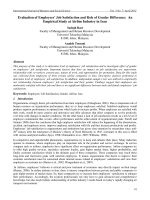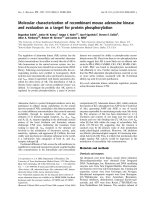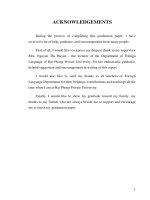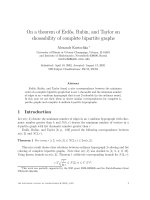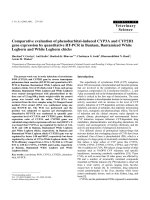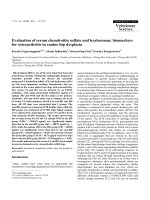Evaluation of “american hotline intermediate” and suggestions on how to use it effectively as a coursebook for intensive english curriculum at junior high schools in ho chi minh city m a thesis 6
Bạn đang xem bản rút gọn của tài liệu. Xem và tải ngay bản đầy đủ của tài liệu tại đây (588.3 KB, 154 trang )
MINISTRY OF EDUCATION AND TRAINING
VIETNAM NATIONAL UNIVERSITY – HCM CITY
UNIVERSITY OF SOCIAL SCIENCES & HUMANITIES
NGUYEN THI MINH LY
EVALUATION OF “AMERICAN HOTLINE-Intermediate”
AND SUGGESTIONS ON HOW TO USE IT EFFECTIVELY
AS A COURSEBOOK FOR INTENSIVE ENGLISH CURRICULUM
AT JUNIOR HIGH SCHOOLS IN HO CHI MINH CITY
A thesis in TESOL
Code number: 04016
SUBMITTED IN PARTIAL FULFILLMENT OF THE REQUIREMENTS FOR THE DEGREE
OF MASTER OF TESOL
SUPERVISOR: DO HUY THINH, Ph.D.
HO CHI MINH CITY – 2009
CERTIFICATE OF ORIGINALITY
I certify my authorship of the thesis submitted today entitled:
EVALUATION OF “AMERICAN HOTLINE – Intermediate AND
SUGGESTIONS ON HOW TO USE IT EFFECTIVELY AS A COURSEBOOK FOR
INTENSIVE ENGLISH CURRICULUM AT JUNIOR HIGH SCHOOLS
IN HO CHI MINH CITY
in terms of the statement of Requirements for Theses in Master’s Programs issued by
the Higher Degree Committee.
Ho Chi Minh City September, 2009
NGUYEN THI MINH LY
i
ACKNOWLEDGEMENTS
I would like to express my deepest gratitude to my supervisor, Mr. Do Huy Thinh,
Ph.D who has devoted a lot of time to helping me finish my thesis. He has read over
and over, commented sincerely, and contributed valuable suggestions to my thesis at
every stage of its development in order to make sure that it makes sense.
I am also grateful to the English-language teachers at Hai Ba Trung, Le Quy Don, Kien
Thiet, Le Loi, Doan Thi Diem junior high schools in the third district and Tran Dai
Nghia grammar school.in the first district of Ho Chi Minh City for their comments and
suggestions on the coursebook American Hotline – Intermediate.
Finally, I would like to thank my family members for their support during the time I
was doing this thesis.
ii
LIST OF ABBREVIATIONS
1. PET
Preliminary English Test
2. FCE
First Certificate of English
iii
ABSTRACT
Learning English has become a real need to the Vietnamese people including children,
adolescents and adults. Children learn English for fun, adolescents for their higher
studies abroad and adults for their jobs. Although their goals to study are different, all
of them have a great interest in English, especially considering it an international
language. However, due to the difference in age, psychology, interests, learning styles
and especially motivation, each group of learners should study an appropriate
coursebook. American Hotline series has been chosen as a coursebook for students of
the Intensive English Program for ten years thanks to its exceptional features.
Nevertheless, there also have been complaints from teachers and students using the
books as well as the students’ parents about inappropriate aspects in the series,
especially at the intermediate level. So far, these issues have not been officially
discussed to find out the best solutions for teaching and learning the books most
effectively. Therefore, the purpose of this thesis is to evaluate American Hotline –
intermediate to see whether it can be adopted in Vietnamese learning and teaching
situation, to explore the potential obstacles students and teachers encounter when using
the book and finally to present some suggestions on how to put it in the most effective
use.
iv
TABLE OF CONTENTS
CERTIFICATE OF ORIGINALITY ………………………………………………………………..I
ACKNOWLEDGEMENTS…………………………………………………………………………..II
LIST OF ABBREVIATIONS……………………………………………………………………… III
ABSTRACT…………………………………………………………………………………………...IV
TABLE OF CONTENTS…………………………………………………………………………… V
CHAPTER 1
1.1.
1.2.
1.3.
1.4.
1.5.
1.6.
1.7.
1.8.
1.9.
INTRODUCTION…………………………………………………………………..1
BACKGROUND …………………………………………………………………….………..1
STATEMENT OF PURPOSE…………………………………………………………………2
RESEARCH QUESTIONS……………………………………………………………………3
SIGNIFICANCE OF THE STUDY………………………………………………….………..3
DEFINITIONS OF TERMS………………………………………………………….………..4
LIMITATIONS………………………………………………………………………………..5
DELIMITATIONS…………………………………………………………………………….5
METHODOLOGY…………………………………………………………………………….6
ORGANIZATION OF THE REMAINDER OF THE STUDY……………………………….6
CHAPTER 2 LITERATURE REVIEW…………………………………………………………..8
2.1. EVALUATION OF A COURSEBOOK………………………………………………………..8
2.1.1. What are language-teaching materials?…………………………………………………….8
2.1.2. The role of materials in language teaching…………………………………………………9
2.1.3. Why do we evaluate coursebooks?………………………………………………………..10
2.1.4. How do we evaluate a course book?………………………………………………………11
2.2. FACTORS AFFECTING ENGLISH LEARNING AND TEACHING………………………13
2.2.1. Learner factors…………………………………………………………………………….13
2.2.2. Teacher factors………………………………………………………………….…………15
2.2.3. Physical conditions of English teaching and learning…………………………………….20
2.2.4. Testing……………………………………………………………………………………..21
2.3. POTENTIAL OBSTACLES IN ENGLISH TEACHING AND LEARNING………………..23
2.3.1. The non-motivation of the students……………………………………………………….23
2.3.2. The learning situation……………………………………………………………………..23
2.3.3. The cultural differences between L1 and L2……………………………………………...24
2.4. SUMMARY…………………………………………………………………………………...25
CHAPTER 3
OVERVIEW OF THE INTENSIVE ENGLISH PROGRAM……….…………26
3.1. PURPOSES……………………………………………………………………………………26
3.2. REQUIREMENTS………………………………………………………………….…………27
3.3. TARGETS……………………………………………………………………………………..28
3.4. THE CURRICULUM……………………………………………………………….………...30
3.5. TESTING……………………………………………………………………………………...31
3.6. THE AMERICAN HOTLINE SERIES…………………………………………….…………32
3.7. SUMMARY…………………………………………………………………………………...32
v
CHAPTER 4
DESIGN AND METHODOLOGY…………………………………….…………34
4.1. RESEARCH SETTING…………………………………………………………….…………34
4.2. RESEARCH QUESTIONS……………………………………………………….…………..35
4.3. RESEARCH DESIGN…………………………………………………………….………….35
4.3.1. The interviews…………………………………………………………………………….36
4.3.2. The questionnaires………………………………………………………………………...36
4.3.3. Class observations…………………………………………………………………………38
4.4. ANALYSIS AND EVALUATION OF AMERICAN HOTLINE-INTERMEDIATE……….38
4.5. SUMMARY…………………………………………………………………………………...39
CHAPTER 5
FINDINGS AND ANALYSIS……………………………………………………..40
5.1. THE ANALYSIS AND EVALUATION OF AMERICAN HOTLINE INTERMEDIATE….41
5.2. COMPARISON BETWEEN THE TEXTBOOK TIENG ANH 9 AND AMERICAN
HOTLINE-INTERMEDIATE………………………………………………………………………...48
5.3. ADVANTAGES AND POTENTIAL OBSTACLES IN TEACHING AND LEARNING
AMERICAN HOTLINE-INTERMEDIATE………………………………………………………….50
5.3.1. Advantages of American Hotline – Intermediate
5.3.2. Potential obstacles in teaching and learning the book
CHAPTER 6
SUMMARY, CONCLUSIONS AND RECOMMENDATIONS………………..60
6.1. SUMMARY…………………………………………………………………………………...60
6.1.1. Strong points…………………………………………………………………….………...60
6.1.2. Weak points………………………………………………………………………………..60
6.2. CONCLUSIONS………………………………………………………………………………61
6.3. RECOMMENDATIONS……………………………………………………………………...61
6.3.1. Recommendations to the editor……………………………………………………………61
6.3.2. Implications for teaching………………………………………………………………….65
6.3.3. Suggestions to the school authority, students and students’ parents………………………70
APPENDIX A
QUESTIONNAIRE FOR VIETNAMESE TEACHERS IN CHARGE OF
TEACHING AMERICAN HOTLINE – INTERMEDIATE AT JUNIOR HIGH SCHOOLS……….71
APPENDIX B
QUESTIONNAIRE FOR NINTH GRADERS STUDYINGAMERICAN HOTLINE
– INTERMEDIATE AT JUNIOR HIGH SCHOOLS………………………………………………….75
APPENDIX C
CONTENT OF TIENG ANH 9 AND AMERICAN HOTLINE – INTERMEDIATE
…………………………………………………………………………………………………………77
APPENDIX D
THE IMPLICATIONS FOR TEACHING EVERY UNIT IN AMERICAN
HOTLINE – INTERMEDIATE……………………………………………………………………….83
APPENDIX E
LESSON PLANNING SHEET FOR AMERICAN HOTLINE – INTERMEDIATE
………………………………………………………………………………………………………..122
vi
Chapter 1
INTRODUCTION
1.1. Background
Nowadays, due to the fast socio-economic development, the requirement to improve
the relationship with other countries is inevitable, especially for developing
countries like Vietnam. It helps widen knowledge and benefit from other countries’
advanced techniques in order to apply to our country’s unique context in the most
effective way. Seeing such advantages, the Vietnamese government has applied the
open policy encouraging the cooperation with foreign countries in every field such
as economy, culture and education. Especially in education, more and more students
study abroad at a very young age. A few years ago, students who had good financial
support usually continued their study at a university in a foreign country after their
high school. These days, they tend to study abroad right after graduating from junior
school. At such a young age, in addition to the experience of leading an independent
life, they also need a means of communication so as to adapt to the new
environment soon. Hence, since they are at the elementary school, their parents want
them to start learning foreign languages, especially English which is considered an
international language. In order to satisfy that requirement, the Department of
Education and Training in Ho Chi Minh put into use a program called Intensive
English Curriculum at the three stages in accordance with three levels of education:
the elementary school, the junior high school and the high school. For each level,
the objectives and teaching materials are different. Elementary school students study
the coursebook named Let’s Go by Steve Wilkinson, Karen Frazier, Ritsuko Nakata
and Barbara Hoskins, published by Oxford University Press. After finishing this sixlevel series, they are expected to be able to get Movers certificate of Cambridge
University. Junior high school students study the coursebook named American
Hotline by Tom Hutchinson published by Oxford University Press. After finishing
1
this four-level series, they are expected to be able to get Cambridge Preliminary
English Test (PET) certificates. Senior high school students study the First
Certificate Examination (FCE) series named Countdown to First Certificate by
Michael Duckworth, Kathy and Jenny Quintana (for grade 10); First Certificate
Knockout by Peter May (for grade 11); and First Certificate Masterclass by Simon
Haines and Barbara Stewart ( for grade 12), which are all published by Oxford
University Press. After finishing this series, students are expected to be able to get
FCE certificates.
After over ten years of being used, Let’s Go series has been considered to be
suitable to the age of the students as well as the requirements of the Department of
Education and Training. Meanwhile, American Hotline series, especially at the
Intermediate level, has been said to contain some items which are unsuitable to the
age of the students as well as Vietnamese conception of education. Therefore, the
evaluation of this series of books in general and the Intermediate level in specific is
necessary. By this way the teacher will be able to see the unsuitable points which
need to be adapted or substituted so as to make use of the book most effectively.
1.2. Statement of Purpose
The purpose of this study is to evaluate AMERICAN HOTLINE – Intermediate
(including the student’s book, the workbook, the teacher’s book, a set of cassettes)
in order to find out if it can be adopted in Vietnamese learning and teaching
situation, to explore the potential obstacles that students as well as teachers
encounter when using the coursebook and finally to present some suggestions to
help them overcome such difficulties so as to employ the book most effectively.
The objectives of this study are to investigate:
1. The evaluation of AMERICAN HOTLINE - Intermediate (the whole
package).
2
2. The potential obstacles that students as well as teachers encounter when
using the coursebook.
3. The implications for teaching and learning the coursebook effectively.
1.3. Research Questions
One main question guides this study:
Is AMERICAN HOTLINE - Intermediate suitable for ninth graders at Vietnamese
junior high schools as the coursebook of the Intensive English Curriculum?
Two sub-questions are also addressed:
1. What are the potential obstacles in teaching and learning AMERICAN
HOTLINE - Intermediate?
2. How can teachers and students use AMERICAN HOTLINE - Intermediate
effectively?
1.4. Significance of the Study
Due to the developments of the society together with the open policy of Vietnam,
the need of improving English language competence is increasing. Therefore, most
Vietnamese parents wish to have their students focus on studying English from the
early age with the hope that their children will be able to get international
certificates soon so as to continue their studies abroad. And the application of the
Intensive English Program at elementary schools, junior high schools and senior
high schools of the Department of Education and Training has fulfilled such an
aspiration because after finishing the program, the students will be able to get FCE
certificates. At the beginning, not including Tran Dai Nghia high school, only a few
schools in Ho Chi Minh City are allowed to open one or two intensive English
classes. However, as the need of improving English has increased more and more,
up to now about 154 schools (including 99 elementary schools, 47 junior high
3
schools and 8 high schools) have intensive English classes. Due to such popularity
of the program, the study on the coursebook to examine its content in order to find
out some suggestions on how to put it in effective use is really necessary.
1.5. Definitions of Terms
Department of Education and Training:
the government body in charge of
education and training of all levels and forms in the city, including foreign language
education curriculum and implementation.
The Intensive English Program: an English Program piloted by the Department of
Education and Training of Ho Chi Minh City with the hope to train students gifted
in English as experts in English so as to fulfill the requirements of the society in
recent times. The opening of intensive English classes also aims to limit the
inefficient English classes for students, which are widely opened in the city. The
program was reviewed and approved by the City People’s Committee in 1998 and
has been carried out over ten years since then.
The junior high school: a school between elementary school (from grade 1 to 5 or 6)
and high school (from grade 9 to 12), usually having two or three grades, variously
including grades 6 through 8 (according to American Ways, 2005, p.p.191-192). In
this study, the term “junior high school” signifies Vietnamese junior high schools,
including four grades (from grade 6 to 9) after elementary schools (from grade 1 to
5).
Textbooks: “Tieng Anh 6, 7, 8, 9” – written by a group of Vietnamese teachers:
Nguyen Van Loi, Nguyen Hanh Dung, Than Trong Lien Nhan, Nguyen Quoc Tuan,
Dang Van Hung, Dao Ngoc Lo, and Tran Huy Phuong and published by Nha Xuat
Ban Giao Duc. The books were first piloted in all junior high schools in the Third
District of Ho Chi Minh City in 2000, then revised by the Ministry of Education and
4
Training and the authors, and finally have been applied in the whole country since
2002.
Coursebooks: American Hotline series – Starters, Progress, Early-intermediate, and
Intermediate – written by Tom Hutchinson, the Associate Director of the Institute
for English Language Education at Lancaster University, England. The series was
published by Oxford University Press in 1997 and first used officially in Vietnam as
the coursebooks of the Intensive English Program during the school year 1998 –
1999. At first, the series was used at some schools in the First District such as Tran
Dai Nghia Grammar School and Minh Duc School and then it has been applied in
47 junior high schools in the whole city up to now.
1.6. Limitations
The investigation covered a period of seven years, from the school year 2001-2002
to the school year 2007-2008. The study particularly emphasized the way to make
use of the coursebook AMERICAN HOTLINE-Intermediate effectively.
The study confines itself to using the coursebook by the researcher herself, and to
interviewing and observing the teachers, the students and the students’ parents
mainly in HAI BA TRUNG School, in certain junior high schools in the Third
District and in TRAN DAI NGHIA Grammar School.
1.7. Delimitations
Due to the purpose of this study, generalizations and recommendations would be
limited to the teaching and learning the coursebook AMERICAN HOTLINE at the
Intermediate level in Vietnamese junior high schools in Ho Chi Minh City.
However, the recommendations might be beneficial to other levels of the
AMERICAN HOTLINE series such as Starter, Progress and Early-Intermediate.
5
1.8. Methodology
This is a descriptive and exploratory study consisting basically of qualitative
methods such as interviews and observations. In addition, questionnaires will be
employed to obtain extra information and clarify the related data.
Data of the intensive curriculum at junior high schools was compiled through the
documents issued by the Department of Education and Training of Ho Chi Minh
City.
Five junior high schools in the Third District (Le Quy Don, Hai Ba Trung, Le Loi,
Kien Thiet, Doan Thi Diem) and Tran Dai Nghia Grammar School, which have
classes taking the intensive program, were selected for observation and data
collection.
The questionnaires were conducted with 10 teachers at the six schools who have
been teaching AMERICAN HOTLINE – intermediate and 114 ninth graders ( 54 at
Hai Ba Trung School and 60 at Le Quy Don School) who have been studying the
coursebook. In addition, five students’ parents from Hai Ba Trung School were
selected for the interviews.
During the study, the researcher worked as an English-language teacher at Hai Ba
Trung School. The researcher’s observation position helped to collect experience
and data for the study. Moreover, the collaboration of English-language teachers in
Tran Dai Nghia Grammar School, whose all classes are under the intensive
program, was a great help for the researcher to explore the issues.
1.9. Organization of the remainder of the study
Chapter II presents a review of the literature and research relevant to this study –
evaluation of a coursebook, factors affecting English learning and teaching and
potential obstacles in teaching and learning English. Chapter III provides an
overview of the Intensive English Program in terms of the purposes, the
requirements, the targets, the curriculum, testing and the cousebook. Chapter IV
6
describes the research design and methodology. Chapter V analyzes and discusses
the research findings: the analysis and the evaluation of American Hotline –
Intermediate, the similarities and differences between the coursebook American
Hotline – Intermediate and the textbook TIENG ANH 9, and the advantages as well
as the obstacles in teaching and learning the coursebook. Chapter VI offers a
summary and conclusions of the study with suggestions on how to put the book in
effective use.
7
Chapter 2
LITERATURE REVIEW
2.1. Evaluation of a coursebook
2.1.1. What are language-teaching materials?
Most people associate the term “language-teaching materials” with coursebooks
because that has been their main experience of using materials. However, according
to Tomlinson (1998, 2), “the term ‘materials’ is used to refer to anything which is
used by teachers or learners to facilitate the learning of a language. They could
obviously be the cassettes, videos, CD-ROMs, dictionaries, grammar books, readers,
workbooks or photocopied exercises. They could also be newspapers, food
packages, photographs, live talks by invited native speakers, instructions given by a
teacher, tasks written on cards or discussions between learners. In other words, they
can be anything which is deliberately used to increase the learners’ knowledge and
experience of the language.” In this sense, materials are divided into two kinds:
authentic and created. Authentic materials refer to texts, photographs, videos
selections and other teaching resources that were not specially prepared for
pedagogical purposes. Created materials refer to coursebooks and other specially
developed instructional resources. Each kind of materials has its own advantages
and disadvantages. However, coursebooks have some typical characteristics that
make it more preferable than other kind of language teaching materials. Firstly, they
provide a structure and a systematically planned and developed syllabus which help
guide learners to the central core of a program. Secondly, they help standardize
instruction, i.e. the students in different classes receive similar content and therefore
they can be tested in the same way. Last but not least, they are efficient because they
provide learners with high-quality materials which are based on sound learning
principles, paced appropriately and especially have been tried and tested.
Consequently, they enable teachers to devote time to teaching rather than materials
8
developing. Due to their convenience, coursebooks are the commonest form of
materials in language teaching.
2.1.2. The role of materials in language teaching
Although kinds of teaching materials differ in some ways and have their own
benefits together with drawbacks, they have common roles in language teaching.
According to Cunningsworth (1995, 7), language teaching materials (particularly
coursebooks) function as:
- a resource for presentation materials (spoken and
written;
- a source
of activities for
learner practice and
communicative interaction;
-
a
reference
source
for
learners
on
grammar,
vocabulary, pronunciation, etc.;
- a source
of stimulation
and ideas for classroom
activities;
- a syllabus (where they reflect learning objectives
that have already been determined); [and,]
- a support for less experienced teachers who have yet
to gain in confidence.
From Cunningworths’ opinion, we can see clearly that coursebooks have impact on
the language program, on the teacher and even on the learners. In many places, the
coursebook serves as a syllabus with a clear framework which helps both teachers
and learners know where they are going and what is coming next so that they can
keep trace of their progress.
For teachers, they provide the carefully planned
selection of language content, the balance of skills taught, and kinds of appropriate
learning tasks for students to practice the language. Some teachers can use them as
their primary teaching resource, but others can use them as supplementary materials.
For learners, materials may provide the major source of contact they have with the
9
language apart from the teacher. With a coursebook, students can learn new
material, review and monitor their progress with some degree of autonomy. In one
word, coursebooks play an important role in the teaching process and greatly
influence on the learning results.
2.1.3. Why do we evaluate coursebooks?
It cannot be denied that the role and uses of materials in a language program are a
significant aspect of language curriculum development. However, it is clear that no
coursebook will ever be a perfect fit for a language program. A book may be ideal in
one situation, but it may turn out to be quite unsuitable in a different situation. So, it
is understandable when Cunningsworth (1995, 14) notes some reasons to evaluate a
material such as “to adopt a new textbook, to identify particular strengths and
weaknesses in a textbook already in use, so that optimum use can be made of their
strong points, whilst their weaker areas can be strengthened through adaptation or
by substituting material from other books.” Littlejohn (1998) also cites some
responses after analyzing and evaluating materials: adopt, reject, adapt, and
supplement the materials.
According to Cunningsworth (1995), evaluation can take place before a coursebook
is used (pre-use evaluation), during its use (in-use evaluation) and after its use (postuse evaluation). Each type of evaluation with its own advantages is applied for a
particular purpose and on a certain circumstance in which the course book would be
used. Pre-used evaluation helps decide whether the coursebook should be chosen for
a language program. In-use evaluation is carried out to see whether the coursebook
should be considered for replacement. Post-use evaluation is useful in helping to
decide whether to use the same coursebook on future occasions. Whatever type of
evaluation is chosen, it is essential to have a look at the context in which the book
would be used. First of all, we need to keep in mind not only the overall aims of the
whole program to be mastered but also the specific objectives in terms of language
10
items, functions and skills to be covered and even how the achievement is measured.
Second, we should look into the learning and teaching situation in terms of the
status and role of English, the intention of the program, the class size and also other
resources available for language learning. Last but not least, information about the
learners (ages, levels, expectations, motivation, interests, previous languagelearning experience, and learning style) as well as the specific aspects of the
teachers (role in educational systems, teaching methodology, personality) should be
taken into consideration. The clear overview of the context in which the coursebook
is used provides us with useful background information contributing to the accuracy
and objectivity of our evaluation.
2.1.4. How do we evaluate a coursebook?
As stated above, material evaluation is really necessary in language teaching since a
good coursebook partly determines the learning results. Therefore, it is essential to
follow certain well-founded criteria before assessing a language-learning
coursebook so as to have an adequate and accurate evaluation. Cunningsworth
(1995), Rowntree (1997) and Tomlinson (1998) state some suggestions of good
materials which can be summarized into four main criteria. First, it should not only
correspond the students’ needs but also match the aims and objectives of the
language learning program. Second, it should provide authentic language that
students can make use of to achieve communicative purposes. Third, it should
facilitate students’ learning processes by making them feel at ease, developing their
confidence and encouraging them to practice. Finally, it should function as a teacher
who provides students with clear presentation, opportunities to practice and enables
them to check their progress. These criteria can be considered a compass to a total
evaluation.
To make it clearer, Cunningsworth (1995) presents a checklist for coursebook
evaluation and selection in terms of aims and approaches, design and organization,
11
language content, skills, topic, methodology, teachers’ books and practical
considerations which can be categorized into two aspects of materials: publication
and design. Littlejohn (1995, 193) defines publication as “the ‘tangible’ or physical
aspects of the materials and how they appear as a complete set or book”; and design
as “the thinking underlying the materials”. Through the design, we can see the aims
of the materials, the selection and sequence of tasks, language and content in the
materials, the nature of the teaching and learning activities. Therefore,
Cunningsworth holds the view that evaluating a coursebook involves an
impressionistic overview of the whole material and an in-depth examination of some
units in the material. The impressionistic overview enables us to have a general look
at the material, e.g. how attractive it is, how many pictures there are, what topics are
introduced, how grammar points are sequenced, etc. However, this impressionistic
overview cannot help us evaluate the material adequately and accurately so that we
can conclude whether it is appropriate to the current teaching and learning situation.
Thus, we need an in-depth examination to see how specific items are dealt with,
especially those which relate to students’ learning needs, syllabus requirements,
how different aspects of language (grammar, vocabulary, phonology, discourse, …)
are dealt with, etc. At this point, both Cunningsworth and Littlejohn suggest
analyzing about 10% to 15% of the material and choosing units around the middle
of the curriculum. This detailed analysis, in Cunningsworth’s opinion (1995, 1),
should aim to look at “the balance of activities and skills contained in a unit, the
potential for learner’s participation, the amount of recycling, etc.”. In one word, an
impressionistic overview of the whole package of the material and an in-depth
examination of some units in the material are necessary for us to have good and
useful insights into the nature of the material in order to take close control over their
design and use.
12
2.2. Factors affecting English learning and teaching
2.2.1. Learner factors
2.1.1.1. The motivation of students
According to Harmer (1992, 3) “motivation is some kind of internal drive that
encourages somebody to pursue a course of action. If we perceive a goal, and if that
goal is sufficiently attractive, we will be strongly motivated to do whatever
necessary to reach that goal.” Motivated language learners perceive goals of various
kinds which can be categorized into long-term and short-term. Long-term goals
relates to an ambition to get a better job, a need to survive in the target language
community (TLC) or a desire to know as much as possible about the culture of the
TLC. On the other hand, short-term goals include such things as wanting to pass an
exam, to beat the opponents in a competition or wanting to be a tourist in the
country where that language is spoken.
Whatever goals they have, strongly
motivated students are easier to teach than those with no such goals. The important
thing is that the reason why they are learning the language will determine the
teacher’s choice of coursebooks, teaching method and even the learning style of
their own.
2.1.1.2. The learning style of students
Our students are likely to differ quite widely in the way they learn. Neville Grant
(1991) made some differences between two kinds of learners who have opposite
personality traits. Firstly, in the way to receive the input, some learners like to have
a written text in front of them even when the aims of the lesson or activity are oral
whereas others like to listen to, and speak the language undistracted by the written
words. Secondly, in the way to acquire the knowledge, some learners feel they learn
best when they are taught grammatical rules in L1 before applying them in
exercises. On the contrary, others like to use their common sense to work out the
13
rules for themselves by listening to the language, reading it and trying to use it.
Finally, in terms of participation, some learners are happiest when the teacher is
completely in charge of the lesson, i.e. they like nothing better than the activity
“teacher talks – students listen”. In contrast, others like to get busy in pairs or
groups, i.e. the teacher, at these times, acts as a kind of referee or manager.
It can’t be denied that the way a course book is designed and the way a teacher
teaches affect the students’ learning style. However, it is the students’ psychology
that distinguishes the learning style of their own from others’.
2.1.1.3. The psychology of students
The psychology of students varies at different age levels, which explains for the
reason why adults and children learn languages differently. Harmer (2007)
categorizes learners into three groups of age: children (from about 2 to 14),
adolescents (from 12 to 17) and adults (over 17). Children are described as the most
motivated learners because they are very curious. They do not just focus on what is
being taught but also learn all sorts of other things at the same time, taking
information from whatever is going on around them. They are so interested in
discovering new things that they rarely sit and listen to the teacher during the class.
According to children, seeing, hearing and touching are just as important for
understanding as the teacher’s explanation. Especially, the younger the students are,
the less effective the abstraction of grammar rules is to them. Children are also
assumed to have the ability to become competent speakers of a new language with
remarkable facility, provided they get enough exposure to it. However, at the same
time, their span of attention or concentration is less than that of an adult. They are
easily distracted after a certain period of time, about forty five minutes. That’s why
Harmer points out that “children need frequent changes of activity: they need
activities which are exciting and stimulate their curiosity: they need to be involved
in something active”. In addition, talking about memory which is really crucial to
language learning, Danny D. Steinberg (1993, 207) states that “the rote memory
14
ability of very young children seems to be excellent in that they easily absorb a
phenomenal amount of data ” and “that memory ability begins to decline when they
get older.” Last but not least, in Harmer’s opinion, children will often seek teacher’s
approval and the fact that the teacher notices them and shows appreciation for what
they are doing is of vital importance. It helps encourage them to study more
enthusiastically.
Unlike children, adolescents are described to have developed a greater capacity for
abstract thought as they have grown up. In other words, their intellects are kicking
in and they talk about more abstract ideas. Moreover, adolescent students have a
great capacity for learning, enormous potential for creative thought and a passionate
commitment to things which interest them. That’s why Harmer emphasizes that the
teacher should choose topics which will reflect their emerging interests. And the
most important point, which teachers of adolescents should take into consideration,
is that adolescence is bound up with a search for identity and a need for self-esteem.
They tend to behave in a way they like and say straightforwardly what they think.
This is often the result the students’ position within their peer group rather than
being the consequence of teacher approval. Therefore, Harmer suggests that
teachers should keep in mind the importance of a student’s place within his or her
peer group and take special care when correcting and assigning roles within an
activity.
2.2.2. Teacher factors
2.2.2.1. The teacher’s personality
Teachers, like everyone else, have a variety of abilities and skills along with their
own qualities. The important thing is that what qualities are necessary to be good
teachers and how they make the best possible use of whatever they have in order to
motivate the students.
15
In 1970, Denis Girard, with the purpose of trying to find the answer to this issue,
carried out a study in which one thousand children aged from twelve to seventeen
were asked to arrange a list of qualities that they expect from a teacher. The result is
as follows: (1 = most important, 9 = least important)
1. He makes his course interesting.
2. He teaches good pronunciation.
3. He explains clearly.
4. He speaks good English.
5. He shows the same interest in all his students.
6. He makes all the students participate.
7. He shows great patience.
8. He insists on the spoken language.
9. He makes his pupils work.
From the study of Denis Girard and his own study on the same subject in 1990,
Harmer (1992, 4) came to some generalizations that “In the first place, the teacher’s
personality matters a lot (and yet this is the most difficult area to quantify or to train
for). But beyond that, it is clear that teachers need to do everything possible to
create a good rapport with their students. Lastly teachers clearly need to be able to
show that they know their subject, they should be able to give clear instructions and
examples and as far as possible have answers to the students’ questions”.
Furthermore, Harmer (2007) adds one more quality of a good teacher is the ability
to adopt a number of different roles in the class, depending on what the students are
doing. At different times, teachers may play the role of a controller explaining
grammar or presenting other information; a prompter encouraging students to
achieve more or feeding in a bit of language or information to help them proceed ;or
an assessor telling students how well they have done or giving them grades. To sum
up, in addition to their own natural personality, teachers should train themselves so
as to acquire qualities that are necessary to be a good teacher.
16
2.2.2.2. The teaching method
Another factor affecting the learning and teaching English is the teaching method
which depends mostly on the teacher. So far, there have been different teaching
methods suggested by lots of experienced educationists such as the grammar
translation approach, the direct method, the audio-lingual approach, the eclectic
approach and the communicative approach. No research has clearly showed the
success of one method over another because each has both advantages and
disadvantages. The matter, as Harmer (1992) points out, is that if students find the
teaching method boring, they will probably become de-motivated whereas if they
have confidence in the method, they will find it motivating. Therefore, what the
teacher should do is to choose the teaching style which they find most suitable for
their students in all ways, especially in terms of their needs. Nowadays, the common
goal of most language learners is to acquire communicative competence which is
defined in “Dictionary of Language Teaching & Applied Linguistics” on page 65 as
follows:
The ability not only to apply the grammatical rules
of
a
language
in
order
to
form
grammatically
correct sentences but also know when and where to
use
these
sentences
and
to
whom.
Communicative
competence includes:
a.
Knowledge of grammar and vocabulary of the
language;
b.
Knowledge
of
rules
of
speaking
(e.g.
knowing how to begin and end a conversation,
knowing
what
topics
may
be
talked
about
in
different types of speech events, knowing which
address
forms
should
17
be
used
with
different
persons
one
speaks
to
and
in
different
situations;
c.
Knowing
different
how
types
to
use
of
and
speech
respond
acts,
such
to
as
requests, apologies, thanks, and invitations;
[and,]
d.
Knowing how to use language appropriately.
In order to help students acquire communicative competence, most teachers choose
communicative approach for its distinctive features raised by Richards and Rodgers
(1986, 71) as follows:
1. Language
is
a
system
of
the
expression
of
meaning.
2. The
primary
function
of
language
is
for
reflects
its
interaction and communication.
3. The
structure
of
language
functional and communicative uses.
4. The primary units of language are merely its
grammatical
categories
and
of
structural
functional
and
features,
but
communicative
meaning as exemplified in discourse.
Finocchiaro and Brumfit (1983) also define communicative language teaching as a
method with a lot of positive characteristics which can be summarized into seven
main features according to different aspects of language as follows:
1. Communicative competence is the desired goal, i.e. language learning is
learning to communicate. Therefore, attempts to communicate are
encouraged at the very beginning although making mistakes may occur.
18
